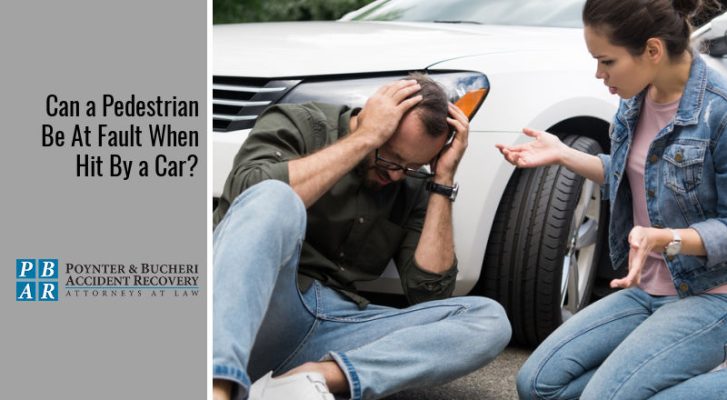
Can a Pedestrian Be At Fault When Hit By a Car?

Pedestrian accidents can have serious or fatal consequences for both drivers and walkers, but pedestrians are at a much greater risk of suffering from serious or fatal injuries. According to a study conducted by Smart Growth America, pedestrian fatalities have increased by 35% in the last decade. And with this dramatic increase, people frequently assume that drivers are at fault.
Many people ask the question, “Can a pedestrian be at fault if they’re hit by a car?” Although pedestrians almost always suffer from more serious injuries than a driver in accidents, they can still be found at fault for a wreck under certain conditions.
In this blog, we discuss when a pedestrian hit by a car could be at fault after an accident. We also discuss important Indiana pedestrian laws, pedestrian and driver duty of care, and Indiana’s comparative negligence laws.
Indiana Pedestrian Laws
Motorists are required to yield to pedestrians, but that doesn’t mean pedestrians have free reign to walk wherever they please at any time. Like motorists, pedestrians have rules that they must follow. If they fail to follow these rules and cause an accident as a result, they could be found partially or wholly liable for a wreck.
Pedestrians must use a crosswalk to cross the road if there’s one available, and before entering the crosswalk, they must first check that vehicles come to a complete stop.
If a pedestrian chooses to cross the road outside of a crosswalk, they must not step in front of an oncoming vehicle that is close enough to be a danger.
Pedestrians are also required to use a sidewalk or shoulder when there’s one available. If there is no shoulder or sidewalk, pedestrians must walk as close to the edge of the road as possible.
Duty of Care
Both drivers and walkers owe a duty of care to others on the road. This means that people need to practice reasonable care given a particular situation. They need to act as a reasonable person would in similar circumstances. For example, if a pedestrian suddenly walked in front of an oncoming car, they failed their duty of care to others on the road. Walking in front of the oncoming vehicle endangered the life of the driver and their passengers. On the other hand, if a pedestrian walks on a crosswalk and a motorist fails to stop their vehicle because they’re distracted, the motorist failed their duty to the pedestrian.
When determining who is at fault after a pedestrian accident, road authorities and insurance companies will investigate and determine if one or more people involved in the wreck broke their duty of care to others on the road.
Who Is At Fault If You Hit a Pedestrian?
Liability after a pedestrian accident depends on whether the pedestrian or driver broke the law and/or failed to act reasonably. Some examples of when pedestrians can legally be at fault for causing a crash include:
- The pedestrian walked on the road rather than on an available sidewalk or road shoulder
- The pedestrian was distracted while walking the road, which led to the accident
- The pedestrian was on the road at night or walked during bad weather conditions
- The pedestrian was under the influence of drugs or alcohol
- The pedestrian entered a crosswalk before the traffic signal indicated that they have the right of way
- The pedestrian didn’t check for traffic before crossing the street
- The pedestrian darted in front of oncoming traffic
When a car hits a pedestrian who’s at fault, the pedestrian could be held liable for the driver’s property and any injuries they may have sustained.
If the pedestrian didn’t break any laws and maintained their duty of care to others on the road, the driver could be at fault. For example, if a driver fails to see a pedestrian that has the right of way, the driver could be liable for the pedestrian’s injuries.
Indiana Comparative Negligence Laws
Although a driver or pedestrian could be wholly at fault for an accident, drivers and pedestrians can also share the blame. For example, if a pedestrian walks on the road when they don’t have the right of way and the driver was speeding at the time, they may both share partial blame. When multiple parties are at fault for an accident, they receive a percentage of the liability. If a pedestrian darted into the road suddenly and the driver was speeding, the pedestrian may be 75% liable while the driver is 25% liable.
Indiana has a modified comparative negligence system. This means that a plaintiff can file a claim against an at-fault driver or pedestrian as long as they share less than 51% of the blame. Additionally, their percentage of blame negatively impacts the amount they can recover in damages. For example, if a pedestrian is found 15% at fault for an accident, that will reduce the amount they can recover in damages by 15%.
Call an Indiana Pedestrian Accident Lawyer
If you’re injured in a pedestrian accident, you need to contact a pedestrian accident attorney. These accidents frequently result in serious and debilitating injuries. When filing against a liable driver or pedestrian, you may be able to recover compensation for property damage, medical bills, lost wages, pain and suffering, loss of future earnings, and more.
For seasoned legal support in Indiana pedestrian accident cases, contact the lawyers at Poynter and Bucheri Accident Recovery Attorneys at Law at 1-800-265-9881. You can also get a free case review here.
